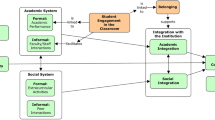Abstract
The development of the Approaches and Study Skills Inventory for Students (ASSIST) is reported, which incorporates a revised version of the Approaches to Studying Inventory. This questionnaire was completed by three separate samples; 1284 mainly first-year students from six British universities, 466 first-year students from a Scottish technological university; and 219 students from a ‘historically disadvantaged” South African university. Analyses of these data were designed to explore the patterns of response found in sub-groups which varied in terms of their levels of attainment and contexts. Maximum likelihood analysis of the largest sample confirmed the expected three factors of deep, surface apathetic, and strategic approaches to studying, and almost identical patterns were also found in the other two samples, and in students having contrasting levels of attainment. There were, however, some interesting minor differences in the South African sample. K-means relocation cluster analysis was then carried out on the largest sample and produced clusters with generally coherent patterns of response. However, one persistent low attainment cluster showed unexpected, dissonant patterns of response, combining moderately high scores on the sub-scales of both deep and surface apathetic approaches, associated with low scores on the strategic approach.
Résumé
Les auteurs rendent compte du développement d’un questionnaire intitulé ‘Approaches and Study Skills Inventory’ for Students’ (ASSIST) qui incorpore une version révisée de ‘Approaches to Studing Inventory’. Le questionnaire a été rempli par trois échantillons distincts: 1284 étudiants de première année de six universités britanniques, 466 étudiants de première année d’une université technologique écossaise, et 219 étudiants d’une université sud-africaine connue pour son public socialement défavorisé. Les analyses de données ont été conduites pour explorer les patterns de réponses trouvées dans les sous-groupes présentant des variations dans leurs niveaux d’acquisition et dans leurs contextes. L’analyse des données réalisée sur le plus grand échantillon confirme l’existence des trois facteurs attendus d’indifférence profonde, d’indifférence de surface et de stratégies d’approche dans les études; des patterns presque identiques ont été également trouvés dans les deux autres échantillons et pour des étudiants ayant des niveaux contrastés d’acquisitions. On a cependant trouvé quelques différences mineures intéressantes dans l’échantillon sud-africain. Une analyse de cluster a ensuite été effectuée sur le plus grand échantillon et a produit des clusters avec des patterns de réponse en général cohérents. On a cependant observé un cluster récurrent et inattendu chez les étudiants en difficulté concernant un pattern dissonant de réponse combinant des scores modérément élevés aux deux sous-échelles d’indifférence profonde et de surface associés à des scores faibles d’approche stratégique.
Similar content being viewed by others
References
Beaty, E., Gibbs, G., & Morgan, A. (1997). Learning orientations and study contracts. In F. Marton, D.J. Housell, & N.J. Entwistle (Eds.),The Experience of Learning (2nd ed.), Edinburgh: Scottish Academic Press.
Calder, I. (1989).The study and learning strategies of students in a New Zealand tertiary institution. Unpublished Ph.D. Thesis, University of Waikato, New Zealand.
Cliff, A.F. (1992).The ‘educationally disadvantaged’ student: Factors impacting upon conceptions of learning and perceptions of learning contexts. Unpublished M.Ed. dissertation, University of Cape Town.
Entwistle, N.J., & Brennan, T. (1971). The academic performance of students. II — Types of successful students.British Journal of Educational Psychology, 41, 268–276.
Entwistle, N.J., & Ramsden, P. (1983).Understanding student learning. London: Croom Helm.
Entwistle, N.J., Meyer, J.H.F., & Tait, H. (1991). Student failure: Disintegrated perceptions of studying and the learning environment.Higher Education, 21, 249–261.
Entwistle, N.J., & Tait, H. (1990). ‘Approaches to learning, evaluations of teaching, and preferences for contrasting academic environments’.Higher Education, 19, 169–194.
Gustafsson, J.-E. (1988). Hierarchical models of individual differences in cognitive abilities. In R.E. Sternberg (Ed.),Advances in the Psychology of Human Intelligence (vol. 4). Hillsdale, NJ: Lawrence Erlbaum.
Gustafsson, J.-E. (1996).Manual for STREAMS. University of Gothenburg, Department of Education and Educational Research.
Janssen, P.J. (1996). Studaxology: The expertise students need to be effective in higher Education.Higher Education, 31, 117–141.
Meyer, J.H.F. (1991). Study orchestration: The manifestation, interpretation and consequences of contextualised approaches to learning.Higher Education, 22, 297–316.
Meyer, J.H.F. (this issue). The modelling of ‘dissonant’ study orchestration in higher education.European Journal of Psychology of Education.
Meyer J.H.F., Parsons, P., & Dunne, T.T. (1990). Individual study orchestrations and their association with learning outcome.Higher Education, 20, 67–89.
Säljö, R. (1979).Learning in the learner’s perspective. 1 — Some common-sense conceptions, (Report 76). Gothenburg: University of Gothenburg, Department of Education.
Tait, H., & Entwistle, N.J. (1996). Identifying students at risk through ineffective study strategies.Higher Education, 31, 99–118.
Tait, H., Entwistle, N.J., & McCune, V. (1998).ASSIST: A reconceptualisation of theApproaches to Studying Inventory. In C. Rust (Ed.),Improving student learning: Improving students as learners. Oxford: Oxford Brookes University, The Oxford Centre for Staff and Learning Development.
Vermunt, J.D. (1996). Metacognitive, cognitive and affective aspects of learning styles and strategies: A phenomenographic analysis.Higher Education, 31, 25–51.
Author information
Authors and Affiliations
Rights and permissions
About this article
Cite this article
Entwistle, N., Tait, H. & McCune, V. Patterns of response to an approaches to studying inventory across contrasting groups and contexts. Eur J Psychol Educ 15, 33–48 (2000). https://doi.org/10.1007/BF03173165
Received:
Issue Date:
DOI: https://doi.org/10.1007/BF03173165



